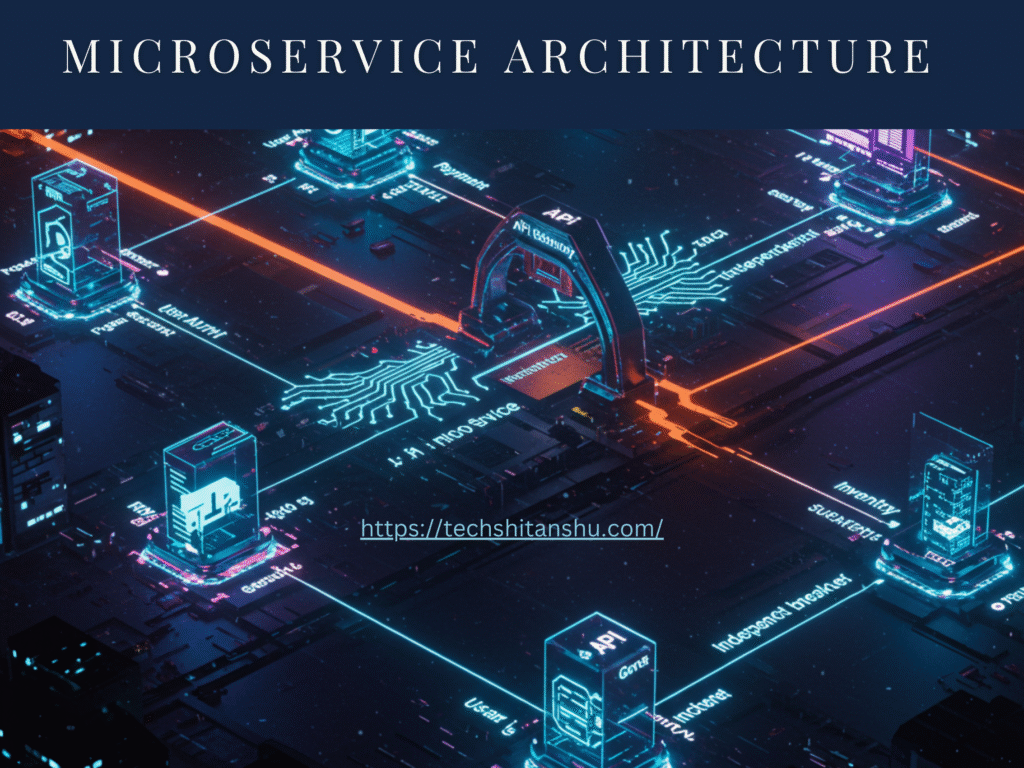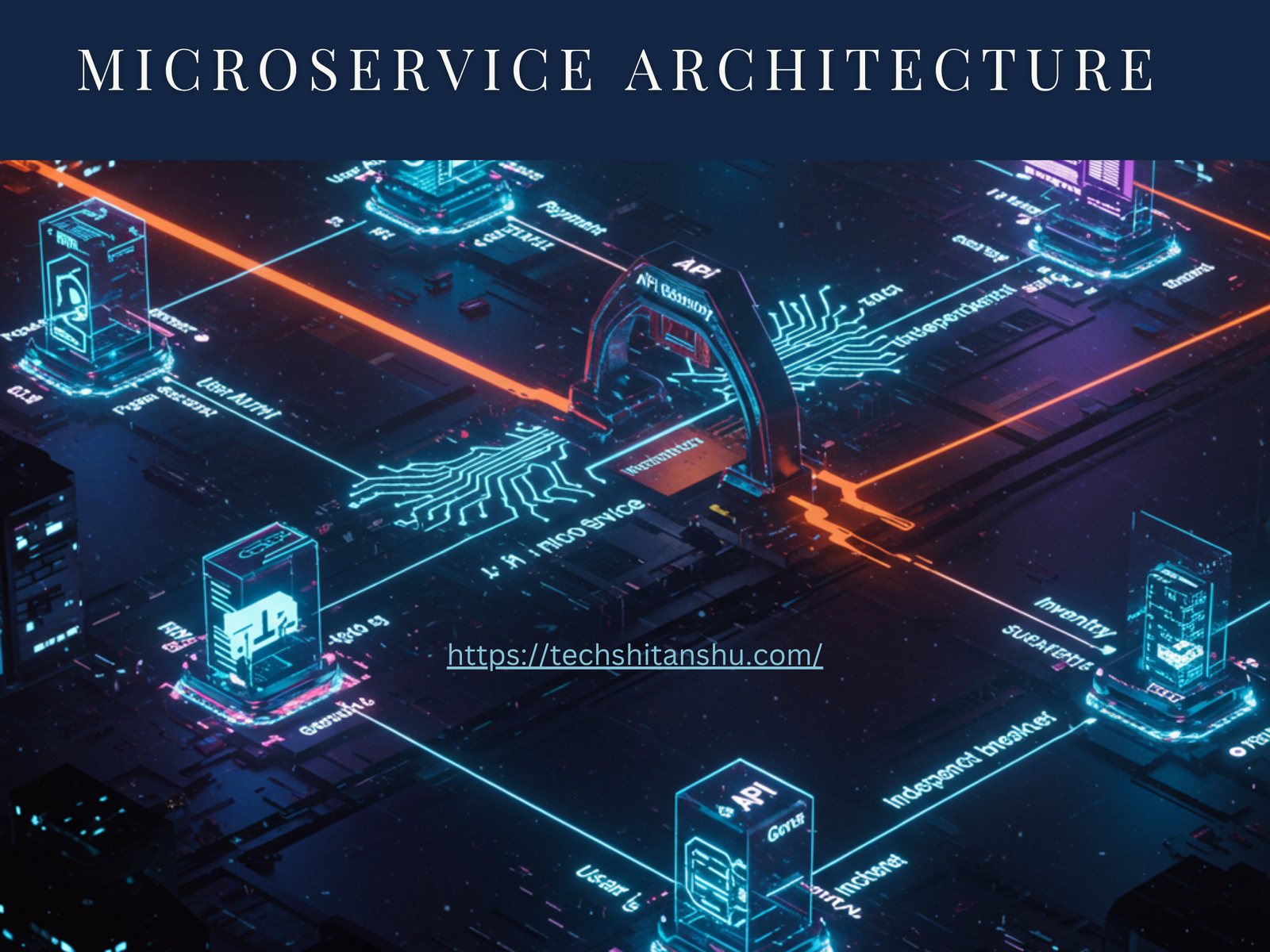Microservice Architecture
What is Microservice Architecture?
Microservices is a cloud-native architectural style where an application is built as a collection of small, independent, and loosely coupled services. Each service:
✔ Runs its own process
✔ Communicates via APIs (REST/gRPC)
✔ Can be developed, deployed, and scaled independently

According to Sam Newman’s “Building Microservices”, a foundational text, microservices are:
- Small, autonomous services: They are independent and self-contained, focusing on a single business capability.
- Loosely coupled: Services can be developed, deployed, and scaled independently without significant impact on other services.
- Communicating via well-defined APIs: Typically using lightweight protocols like HTTP/REST or asynchronous messaging.
- Organized around business capabilities: Teams own services that align with specific business domains (e.g., order management, user profiles).
- Independent deployment: Each service can be deployed without deploying the entire application.
Martin Fowler and James Lewis’s article “Microservices” (often cited as a primary resource, acting as a concise summary of the architectural style) emphasizes:
- Componentization via services: Services as deployable units.
- Products not projects: Long-lived teams focused on product ownership.
- Decentralized governance: Teams choose their own technologies and tools.
- Smart endpoints and dumb pipes: Communication via simple protocols, not complex ESBs.
- Automated infrastructure: DevOps practices for continuous delivery.
- Design for failure: Services must be resilient to failures in other services.
- Evolutionary design: The architecture can evolve over time.
Key Characteristics & Principles of Microservice Architecture (From various books):
| Feature | Description |
|---|---|
| Decentralized | No single database; each service has its own DB |
| Independent Deployment | Update one service without affecting others |
| Polyglot Persistence | Different databases per service (SQL, NoSQL, etc.) |
| Resilient | Failure in one service doesn’t crash the whole system |
| Scalable | Scale only the services under heavy load |
- Bounded Context (Domain-Driven Design): As highlighted in Eric Evans’s “Domain-Driven Design” (which predates microservices but heavily influences their design), each microservice should encapsulate a specific “bounded context.” This means a clear boundary around a particular domain model, preventing “leaky abstractions” and ensuring consistency within that context in Microservice Architecture .
- Decentralized Data Management: Instead of a single, shared database, each microservice often owns its data store. This is crucial for independent deployment and scaling. Newman discusses various approaches like polyglot persistence (using different database technologies best suited for a service’s needs).
- API Gateway: Chris Richardson’s “Microservices vs. SOA” (and other resources) often describe the API Gateway pattern. This acts as a single entry point for clients, routing requests to appropriate services, and handling cross-cutting concerns like authentication, rate limiting, and logging.
- Circuit Breaker: Introduced as a critical resilience pattern in Michael Nygard’s “Release It!”, the circuit breaker prevents a failing service from cascading failures throughout the system. When a service experiences too many failures, the circuit “trips,” preventing further calls to that service until it recovers.
- Service Discovery: How do services find each other? Books cover patterns like client-side discovery (e.g., Eureka, Consul) where the client queries a registry, or server-side discovery (e.g., AWS ELB, Kubernetes).
- Logging and Monitoring: With distributed systems, centralized logging (e.g., ELK stack) and distributed tracing (e.g., OpenTracing, Zipkin) become paramount for understanding system behavior and debugging issues. Adrian Cockcroft (known for his work at Netflix) extensively promotes these operational aspects.
- Configuration Management: Externalizing configuration is vital. Tools like Spring Cloud Config or Consul are often discussed for managing configurations across many services.
- Security: Implementing security in a distributed environment requires careful consideration. Books discuss token-based authentication (OAuth2, JWT), API keys, and secure communication channels (TLS/SSL).
- Testing in Microservices: This is more complex than monolithic testing. Books advocate for different levels of testing: unit, integration (contract testing being particularly important, as detailed in “Microservice Architecture: Aligning Principles, Practices, and Culture” by Irakli Nadareishvili, Ronnie Mitra, Matt McLarty, and Mike Amundsen), and end-to-end testing.
- Deployment Strategies: Techniques like blue-green deployments, canary releases, and rolling updates are crucial for deploying microservices with minimal downtime and risk.
Challenges and Considerations of Microservice Architecture :
Books also extensively cover the challenges of microservices:
- Increased Operational Overhead: More services mean more to deploy, monitor, and manage. Automation (DevOps) is key.
- Distributed Transactions: Handling transactions across multiple services is complex (e.g., Saga pattern).
- Data Consistency: Ensuring eventual consistency across services can be challenging.
- Network Latency and Reliability: Inter-service communication introduces network overhead and potential failures.
- Debugging and Troubleshooting: Tracing requests across many services can be difficult without proper tooling.
- Team Organization: Requires a shift towards small, autonomous, cross-functional teams.
- Complexity: While individual services are simpler, the overall system complexity increases.
Core Components of Microservice Architecture
A. Service Components
API Gateway (Entry point for clients, e.g., Kong, Apigee)
Service Discovery (Eureka, Consul)
Load Balancer (NGINX, Istio)
Config Server (Centralized config management)
Circuit Breaker (Hystrix, Resilience4j)
B. Communication Protocols
C. Data Management
Event Sourcing (CQRS, Kafka Streams)
Saga Pattern (For distributed transactions)
Microservice Architecture Pros & Cons
✅ Advantages
✔ Faster deployments (CI/CD pipelines per service)
✔ Better fault isolation
✔ Easier to scale (e.g., only scale the “Payment Service” during peak sales)
✔ Flexible tech stack
❌ Challenges
✖ Complex debugging (Distributed tracing needed)
✖ Network latency (Service-to-service calls)
✖ Data consistency (Requires eventual consistency patterns)
Microservice Architecture Real-World Examples
Netflix (500+ microservices handling streaming, recommendations, billing)
Uber (Separate services for rides, payments, notifications)
Amazon (Thousands of microservices powering AWS)
When to Use Microservices?
✔ Large-scale applications with multiple teams
✔ Need for independent scaling (e.g., “Search Service” vs. “Checkout Service”)
✔ Frequent feature updates
Microservice Architecture Takeaways
🔑 1. Microservices Are Small, Independent Units
Think of each microservice like a Lego block — it does one thing really well, and can be changed or replaced without breaking the whole system. This is different from a monolith, where everything is glued together.
🔑 2. Smart Endpoints, Dumb Pipes
Each microservice should be smart on its own, meaning it handles its logic internally. The way services talk to each other (usually via APIs) should be simple and lightweight — no complicated message queues or dependencies unless necessary.
🔑 3. You Build It, You Run It
Teams should own their microservices completely — from writing the code to deploying and maintaining it. This improves accountability and helps catch issues early.
🔑 4. Decentralize Everything (As Much As Possible)
From databases to decision-making, microservices work best when each service is independent. If every service shares one database, you’re back to a monolith. Better to give each one its own.
🔑 5. Communication Between Services Is Tricky
Microservices talk over the network, which can fail or slow down. So, your design must handle failures gracefully, using tools like timeouts, retries, and circuit breakers (think: backup plans).
🔑 6. Design Around Business Capabilities
Instead of breaking things by technology (like “frontend” or “backend”), organize microservices around business domains — like “Billing”, “User”, or “Inventory”. It’s closer to how your users and teams think.
🔑 7. Monitoring and Logging Are Non-Negotiable
Because there are so many moving parts, having good logs, metrics, and dashboards is critical. Without visibility, debugging becomes a nightmare.
🔑 8. Don’t Rush into Microservices
If your team or product isn’t mature enough, don’t split into microservices just because it’s trendy. Sometimes a well-structured monolith is a better starting point.
Microservice Architecture Recommended Books for Deeper Dive:
- “Building Microservices” by Sam Newman: Often considered the bible for microservices. It provides a comprehensive overview of the architectural style, design principles, and practical considerations.
- “Microservices Patterns” by Chris Richardson: A catalog of patterns for building microservice-based applications, covering topics like communication, data management, and deployment.
- “Distributed Systems Design” by Sam Newman (upcoming): While not yet released, this will likely expand on the distributed aspects touched upon in “Building Microservices.”
- “Release It!: Design and Deploy Production-Ready Software” by Michael T. Nygard: While not exclusively about microservices, its focus on resilience patterns (like Circuit Breakers, Bulkheads) is invaluable for building robust distributed systems.
- “Domain-Driven Design: Tackling Complexity in the Heart of Software” by Eric Evans: Essential for understanding how to break down complex domains into bounded contexts, which is fundamental to microservice design.
- “Monolith to Microservices: Evolutionary Patterns for Transforming Your Existing System” by Sam Newman: Focuses on the practical aspects of migrating from a monolithic application to microservices.
- “Microservice Architecture: Aligning Principles, Practices, and Culture” by Irakli Nadareishvili, Ronnie Mitra, Matt McLarty, and Mike Amundsen: Discusses the cultural and organizational shifts required for successful microservice adoption.


Leave a Reply